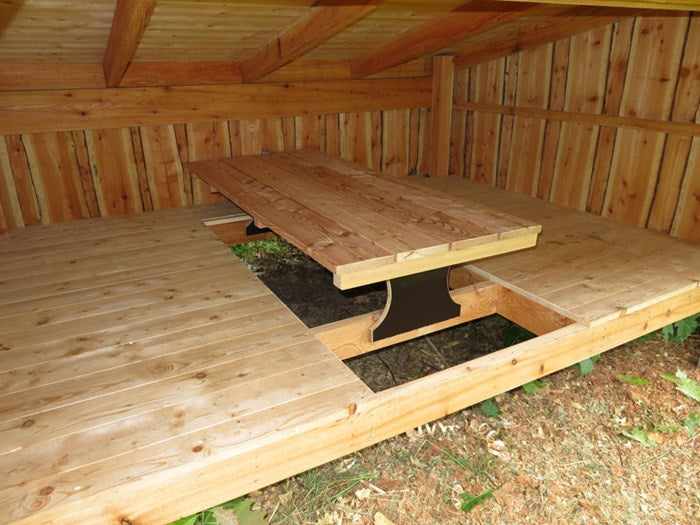How to build a shelter, where to put it and much more
How to build a shelter? We review that here! So you've come to exactly the right place.
Table of contents
- How to build a shelter?
- Should you treat your shelter or fire pit with wood protection?
- Is a shelter with a straight roof or gable roof best?
- Which roof to choose: grass roof or roofing felt for shelters?
- How should I place my shelter in relation to sun and wind?
How to build a shelter?
Basically, you can build a shelter from either whole or partially cut trunks ( solid timber ), planed boards or planks, or kalmar boards ( boards with bark on the edges ).

Building a shelter is a small project in which most people with "hands on" can be involved.
Shelters can be purchased either in construction kits, where you get all materials delivered in raw lengths without any kind of processing, or in build-it-yourself shelter assembly kits, where the individual parts for the shelter are partially assembled and cut to size.
Always pay attention to what is included or rather not included in a construction or assembly kit. A good price for a shelter may turn out to be a not so good price if you subsequently have to buy screws, a good roof, etc.
Also remember to be aware of which tool is to be used.
Should you treat your shelter or fire pit with wood protection?
It is often doubtful whether treatment with wood protection of shelters and fire cabins will significantly extend the lifespan. If it is a quality product, the shelter or fire cabin is constructed with careful consideration of constructive wood protection, in short: no wood in contact with the ground, large overhang, etc. which means that the wood is not moistened and thus rots.
Paint or not, will therefore largely be a matter of appearance: if the "warm glow" the wood has when fresh is preferred, a transparent product such as e.g. "GORI 2 in 1" in pine. If you don't paint, the wood will patina and over time get a white-grey surface.
Is a shelter with a straight roof or gable roof best?
A shelter is available with either a straight roof or a gable roof. A straight roof is one-sided sloping backwards, while a pitched roof is characterized by the roof "cracking".

Straight roof has the following advantages:
- Gives a lot of light inside the shelter
- All the water from the roof runs backwards and thus the space in front of the shelter is always dry.
- Option to make a fire under the roof overhang
- Easy to get in and out of the shelter, there is usually standing height under the roof overhang
Straight roof has the following disadvantages:
- Risk of driving rain with strong winds, primarily due to incorrect location
Gable roofs have the following advantages:
- Can provide better protection against wind and weather
- More "cave-like" shelter
- Better protection against "neighbor peeking"
Gable roofs have the following disadvantages:
- Not possible to have a fire in front under the roof overhang
- You have to bend down to get in and out
- Great risk of "spills" in front of the shelter due to water from the roof
As stated above, there are both advantages and disadvantages to the two types of roof on a shelter. It is therefore largely a matter of taste and preference, but based on practical experience, we believe that a shelter with a straight roof provides the greatest utility value.
Which roof to choose: grass roof or roofing felt for shelters?
Thatched roofs make a shelter look very "natural" out in nature and blend in well with the surrounding vegetation.
Grass roofs make the roof of a shelter quite a bit heavier, and a rather strong construction is thus required to support the roof.
A shelter with roofing felt will often fit better in a garden, together with other buildings, where the "light" appearance fits better than the somewhat heavier grass roof.
The construction time is almost the same, but especially due to the stronger construction for a grass roof, this makes this solution slightly more expensive than a roofing felt roof.
The advantage of a grass roof is that it does not get hot during the afternoon. Especially an advantage when used in children's institutions where you have to sleep for dinner.
A shelter with a corrugated iron roof can get hot on a summer's day, but at night the temperature is the same in the two types.
How should I place my shelter in relation to sun and wind?
Shelter placement is a bit of a science, but also depends on your preference. Should I place my shelter to the west to get the evening sun? Or to the east so I get the sun in the morning and what about the wind?
Placement of the shelter is often a bit of a compromise, where it is about getting as much sun as possible and as much shelter as possible. A location to the north-west / north provides evening sun during the summer half year, and very rare wind from the north during the summer period.
Having said that, surrounding trees, bushes and other things can have an effect on wind and light conditions, so it will always be up to an individual assessment.
We will be happy to help you choose the right location before we set up a shelter for you or hand over the build-it-yourself kit. It's just asking.
Are you curious and want to know even more about shelters and their use? See more questions and answers about shelters and fire cabins here


